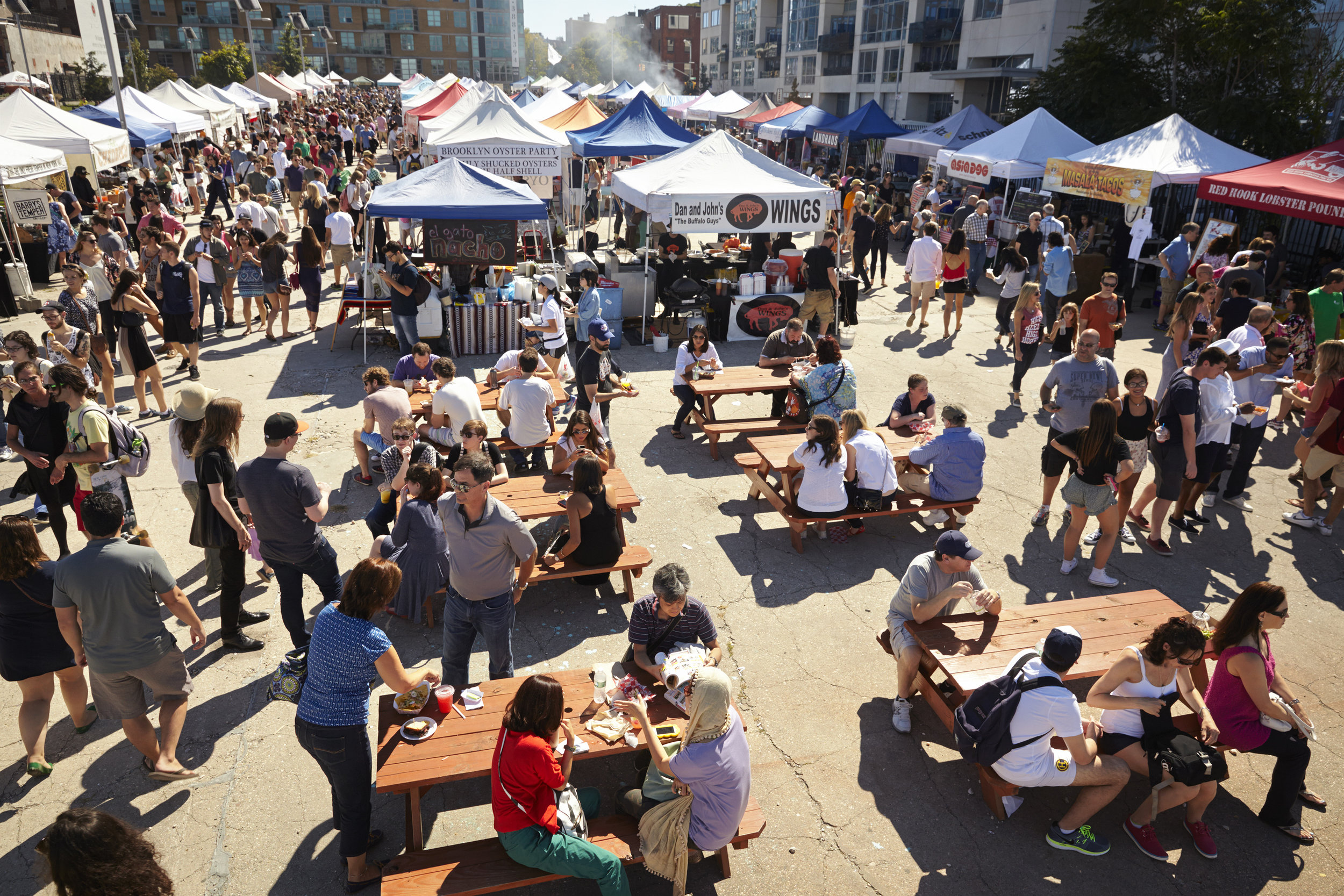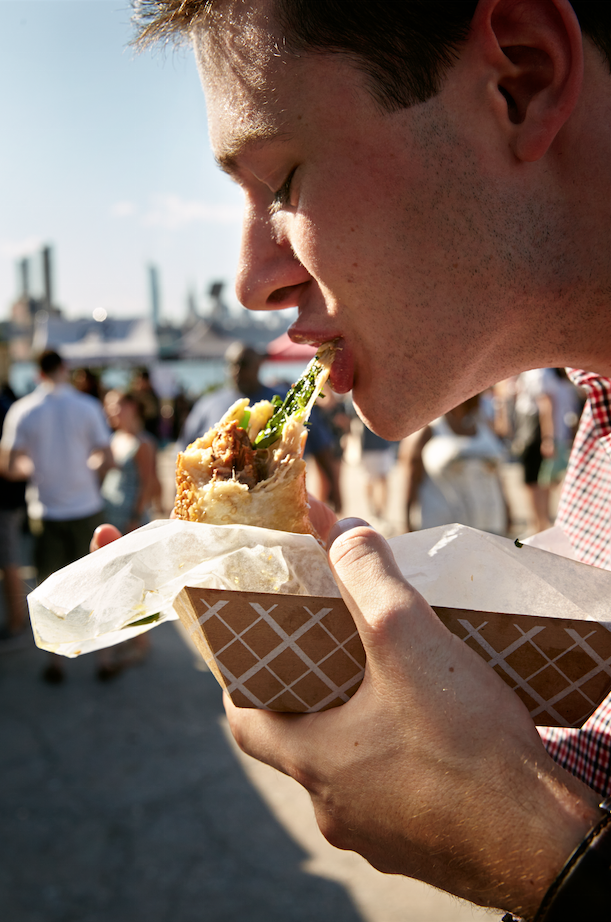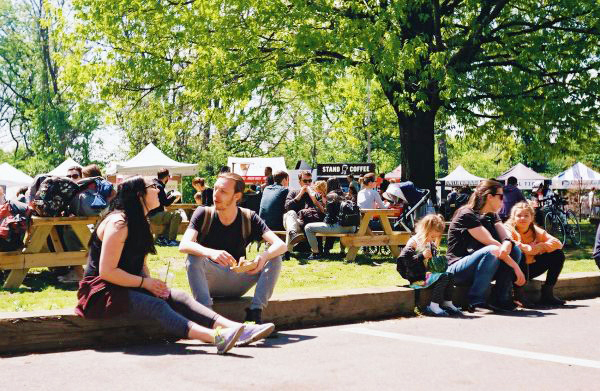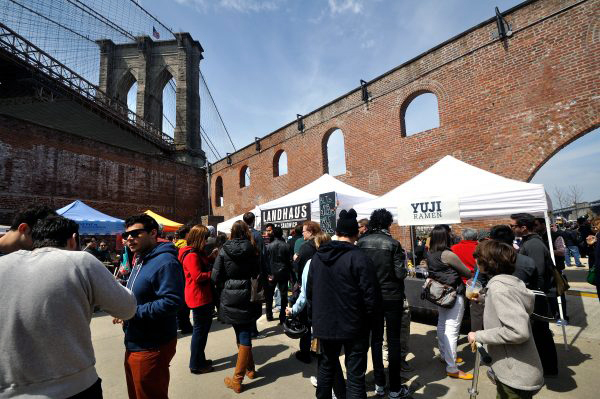
At their best, open-air street markets foster lively neighbourhood settings in which people can mix and celebrate community life. Residents and visitors alike head to markets not only to buy goods but also to experience the everyday pulse of life in a city.[1] Over the past decade, open-air food markets have seen a resurgence in popularity in many neighbourhoods across the U.S.
Topmost photo: Smorgasburg happens every Saturday on the Williamsburg waterfront at East River State Park, featuring packaged and prepared foods, purveyors from New York City and across the region. Photo from www.smorgasburg.com.
How might these markets promote more inclusive cities? What are the elements that make them inclusive for both vendors and the public at large? To start, entrepreneurs can open a stall with low capital. Low barriers of entry enable people who might not be able to open a bricks-and-mortar restaurant (for example, recent immigrants) to set up shop. Additionally, consumers can enjoy a variety of restaurant quality food for below-restaurant prices. Because markets are based on human interactions, people may end up intermingling with both familiar as well as unfamiliar persons. In turn, visitors develop ties of “public familiarity.”[2] Older adults and groups with few preexisting social ties may use the market as spaces to forge and uphold social relationships.[3] For surrounding neighborhoods, well-functioning markets can, furthermore, invigorate otherwise dull streets or plazas.[4]

America, attracting 20,000–30,000 people to Brooklyn
each weekend to eat from 100 local vendors. Photo from
www.smorgasburg.com.
New York City’s Smorgasburg is the nation’s largest open-air street food market—a veritable foodie mecca. Though providing a singular experience, I thought it would be worthwhile to visit Smorgasburg to learn about changing trends in the city’s street food markets. Before I describe my time there, it’s worth summarizing a bit of recent history on local street market policy.
In 2006, the Centre for an Urban Future reported that New York City’s street markets had grown quite generic. Of all the food permits distributed by the City’s Health Department, 46% were held by a mere 20 vendors. What’s more, nearly half of these vendors were based outside of New York City.[5] For visitors, this meant the same sunglasses, T-shirt, and kebab stands could be found at most markets throughout the five boroughs. The Bloomberg Administration’s response was to implement new regulations meant to encourage markets to hire local vendors. These regulations also made obtaining permission to hold a market in the street a more difficult process, as they sought to lessen the cost of the city having police work overtime to close down and patrol the street.[6]
This policy has, in turn, led to a concentration of “street food” markets in which vendors sell pre-prepared food in designated public spaces (and not in the street). Smorgasburg may be indicative of this broader change in the structure of markets in NYC.
Smorgasburg takes place in two Brooklyn locations: Williamsburg and Prospect Park. On a Sunday afternoon, I went to the latter to speak with vendors and customers about their perceptions of the market. Conversing with vendors, it became clear that while the price of opening a food stall remains relatively low, the competition for opening a stall is less about having the required capital than having unique selling points for the market committee. Many vendors distinguish themselves by either having won prizes at other food festivals/markets, or by having an established name on social media sites such as Instagram.

Sitting and enjoying the food at Smorgasburg in Prospect Park. Photo by Jana Markova.
There is still the odd case of an unknown entrepreneur with an original idea who, with great success, opens a stall at Smorgasburg. But most of the vendors I talked to explained that Smorgasburg is a difficult place to achieve this dream, since new vendors generally must exhibit pre-established brands. With an acceptance rate of between 8.5 and 11%, it rivals the likes of Ivy League schools such as Brown University, which has an acceptance rate of 9.6%.[7] So, while the market boasts of its local vendors, its popularity (and selectivity) makes it fairly inaccessible for local food entrepreneurs. Although this, in some senses, does not diminish the value of Smorgasburg, as it encourages those who want to open stalls to be serious entrepreneurs, it doesn’t benefit potential vendors who do not already have a brand and store—and these often include recent immigrants or new entrepreneurs.

Wikimedia Commons User Patrickneil.
Similarly, the consumers visiting Smorgasburg are generally not community- or neighborhood-based, with most of my interviewees saying it was their first time at the event. Many also stated that they do not generally spend time in Prospect Park. In this sense, the community interactions valued in many traditional marketplaces are partially lost; the casual contact (meaning the natural, organic interactions that occur in the market space) is less constant, and consumers do not form lasting bonds with vendors or strangers. Moreover, the age group at the market was predominantly adolescents and young families, with few older adults attending the market. Smorgasburg appeared as a destination market for young people seeking great food experiences, with many visitors saying they had come after hearing about it on Instagram, rather than a neighbourhood market able to bring the community together.
Smorgasburg attracts residents from around the city, and tourists from around the world, and so in this sense it is inclusive. It also attracts talented vendors serving an array of foods. Yet other cities that are hoping to emulate Smorgasburg should recognize it for what it is: more of a destination for tourists than a neighborhood-focused gathering space, with high barriers to entry for vendors.
New York City’s ability to host more (and more inclusive) open-air street food markets is surely challenged by its density and the costs associated with closing streets. But other cities such as London nonetheless maintain and prioritize street food markets. New York could also benefit from more dispersed, community-based street food markets throughout the five boroughs, with local vendors.
What’s an example of an inclusive open-air food market in your city? Write to us at admin@gehlinstitute.org! 
Footnotes:
[1] Schappo, Patrícia, and Rianne Van Melik. “Meeting on the marketplace: on the integrative potential of The Hague Market.” Journal of Urbanism: International Research on Placemaking and Urban Sustainability 10, no. 3 (2016): 318-32. doi:10.1080/17549175.2016.1223741.
[2] Schappo, Patrícia, and Rianne Van Melik.
[3] Watson, Sophie. “The Magic of the Marketplace: Sociality in a Neglected Public Space.” Urban Studies 46, no. 8 (2009): 577-591. doi: 10.1177/0042098009105506.
[4] The Economist. “Sandwich spread—the Rise of Decent Outdoor Dining.” The Economist (London), March 8, 2014. http://www.economist.com/news/britain/21598667-rise-decent-outdoor-dining-sandwich-spread.
[5] Bowles, Jonathan and Tara Colton. “Rethinking New York’s Street Fairs.” Center for an Urban Future. August, 2006.
[6] Levy, Nicole. “Here’s What the Future of City’s Street Fairs Could Look Like.” DNAinfo New York. June 09, 2016. Accessed June 28, 2017. https://www.dnainfo.com/new-york/20160609/chelsea/heres-what-future-of-citys-street-fairs-could-look-like.
[7] Fox, Alison. “Smorgasburg’s Exclusive Secret to Success.” The Wall Street Journal, April 5, 2013. https://blogs.wsj.com/metropolis/2013/04/05/smorgasburgs-exclusive-secret-to-success/.
This article was reprinted in its entirety through the courtesy of the Gehl Institute. Read the original article here.

